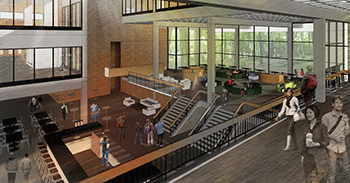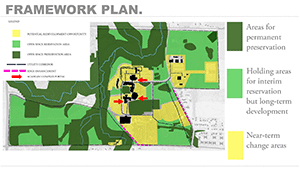Master Plan unveiled
Updated at 10 a.m., Wednesday, Oct. 29
When University of Wisconsin-Parkside Chancellor Debbie Ford opened the faculty, staff and student 2014 Master Plan Presentation Monday morning in the Student Center Cinema, she asked those in attendance to think back 20 years.
"We didn't have the Internet like we have it today," Ford said. "We certainly didn't carry around mini-computers and smartphones. Think about how many changes have occurred. So putting together a master plan is really our best speculation about what the future needs will be for our campus community."
The 2014 Master Plan, Ford said, takes into account the needs of our students today and well into the future. "Many students will never set foot on our campus, but they will be graduates of the University of Wisconsin-Parkside," Ford said. "I'm excited about how this master plan builds on what we have been able to do here, and provides for a quality learning environment for everybody with a particular focus around our students."
In addition to the formal presentation, an afternoon open house gave faculty, staff, students and the community the opportunity to ask questions of the Master Plan Core Team and representatives from agencies that assisted with development of the plan.
Architects' rendering of Main Place as part of the master plan; read more on the Wyllie Hall design

Final Piece of the Planning Process
The 2014 Master Plan is the final piece of the integrated planning process at Parkside, Ford said. Other planning elements include the strategic plan; academic plan; technology road map; and the strategic enrollment management plan. The current master plan is the third in the history of the university.
Jon Hoffman, associate planner with design consultant SmithGroupJJR, described the university as a "start from scratch" university. The 1969 Master Plan, Hoffman said, provided for up to 25,000 students to be on campus. Just a few years after the university was founded, it was incorporated into the new University of Wisconsin System along with nine former Wisconsin State University comprehensive institutions. With that incorporation, came a major change in the projected enrollment for the campus.
The 2006 Master Plan was the first update to the original plan, and looked at the role of Parkside within the UW System. Hoffman described the 2006 plan as a "rousing success." From that plan came the Student Center, Pike River Suites, the Rita Tallent Picken Regional Center for Arts and Humanities, and the enhanced roadway system to access campus.
The guiding principles of the 2014 Master Plan:
- Future-forward campus
- Increase the variety of learning environments
- Enhance inclusiveness and student focus
- Improve facility function and efficiency
- Further enhance and balance campus sustainability
Distance Learning
Prairies and Woodlands Preserved

Framework Plan Key:
Dark Green
Areas for permanent preservation, highest quality environmental areas: flood plain, wetlands, old-growth forest, restored prairies and other spaces that have significant building restrictions because of their importance as environmental resources. The 2014 Master Plan recognizes these areas and suggests that they be permanently preserved.Light Green
Yellow